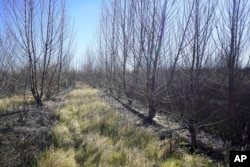Between huge almond farms and dairy fields in the heart of California’s farm country sits a property under redesign. Engineers are seeking to return the land there to what is was like 150 years ago, before dams changed the flow of its rivers.
The 1,100-hectare property sits on land where the Tuolumne and San Joaquin rivers meet in the state’s Central Valley. It is being recreated as a floodplain. Floodplains are areas where rivers often overflow from heavy rains. They are home for whole ecosystems.
The Dos Rios Ranch Preserve is California’s largest single floodplain rebuilding project. It is part of a larger national effort to reconsider how rivers should flow as the climate changes. The land it covers used to be a farm. But the owners sold the farm to the nonprofit River Partners to use for a wildlife habitat.
California’s government wants to do similar projects that lower risks to property and also lead to things like improving the water supply. By removing dams, rising rivers can flow onto land that no longer needs to be kept dry.
“It's giving new life ecologically but in a way that's consistent with, complementary to, the human systems that have developed over the 150 years since the Gold Rush,” said Julie Rentner. She is president of River Partners.
The Central Valley covers about 51,800 square kilometers. It is an agricultural powerhouse. It makes up about one percent of the nation’s farmland but produces 25 percent of the nation’s food. More than 250 crops grow in the area. It also is home to about one-fifth of all groundwater pumping in the U.S.
A flood in the 1860s demonstrates the possibility for disaster. But the state's population and farm production quickly grew through the 20th century. The government built huge new water redirection systems. The water supplies supported people and farms, and the dams protected cities and crops.
The dams generally cut off rivers from their natural floodplains. As climate change causes temperatures to warm, mountain snow can fill rivers much faster, increasing the flows so much that dams fail.
Floodplain recreation can help. For projects like Dos Rios, land that farmers no longer want to use is being turned into space where rivers can overflow.
California officials began centralizing valley flood planning ten years ago. In 1997, major storms caused flood barriers to break throughout the valley, including on the Tuolumne River. Nine people were killed and more than 20,000 homes were destroyed. Total damage costs in the area reached $2 billion.
Officials have updated the Central Valley Flood Protection Plan. It details ways to lower flood risk and protect the 1.3 million people who live on floodplains.
Dos Rios is one of 17 floodplain projects identified by the state. Four have been completed since 2013. Three projects are active and 10 more are proposed. They have cost $300 million so far. Money has come from local and federal resources.
“Dos Rios is an amazing example, but we need like 30 more of those,” said Jane Dolan. She is chair of the Central Valley Flood Protection Board.
Similar projects are taking place around the country. The Biden administration has proposed at least $1.75 billion in an infrastructure bill for projects aimed at reducing flood risk.
Just as climate change is making California’s dry periods drier, it is also expected to make the wet periods wetter. The state experienced major rain and snowfall in December. Then, it experienced its driest January through March on record.
“One of the things that drives me crazy about California water is that decision makers want to talk about floods in flood years and droughts in drought years,” said Barry Nelson. He is a water control expert who worked on the Dos Rios project.
Since the 1850s, 95 percent of the historical wetlands and river habitats in the Central Valley have been destroyed.
The property Dos Rios sits on was most recently a dairy. Its owners began discussing a possible sale to River Partners for conservation in the mid-2000s.
River Partners has planted fourteen kinds of woody trees and other plants designed to appeal to native species. The group said the habitat supports the Aleutian cackling goose, which used to be listed as an endangered species. Dos Rios is also home to the riparian brush rabbit, chinook salmon, steelhead trout, the yellow warbler, and the sandhill crane.
Supporters of such projects would like to see them built faster in California and beyond. Rentner, of River Partners, said there is general agreement on the value of recreating floodplains. But there are also debates over costs and other issues that can slow work down, she noted.
In the complex world of California water, floodplain recreation stands out, expert Barry Nelson said.
“In this sort of ocean of disagreements about water policy, about all these other issues,” he said, flood control policy has seen “broad support.”
I’m Caty Weaver. And I’m Ashley Thompson.
Caty Weaver adapted this story for VOA Learning English from a report by The Associated Press.
________________________________________________________________
Words in This Story
habitat -n. the place where a plant or animal grows or lives in nature
consistent -adj. always the same
complementary -adj. serving to make whole or improve something
powerhouse -n. a person or thing of unusual strength or energy
infrastructure -n. the system of public works of a country, state, or region
drive crazy v. to upset, frustrate or anger someone
drought -n. a long period of time during which there is very little or no rain
species -n. a class of things of the same kind and with the same name
We want to hear from you. Write to us in the Comments section, and visit our Facebook page.











